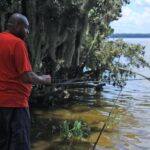A fish dwelling close to drainage retailers on the Fukushima Daiichi nuclear energy plant in Could contained ranges of radioactive cesium which are 180 occasions Japan’s security restrict.
The black rockfish caught on 18 Could was discovered by plant operator Tokyo Electrical Energy Firm (Tepco) to have 18,000 becquerels per kilogram of cesium-137, in contrast with the authorized most stage of 100 becquerels per kg.
Japan’s plan to launch 1.3m tonnes of handled water from the Fukushima plant has sparked concern within the area, regardless of approval from the UN’s Worldwide Atomic Vitality Company (IAEA). Hong Kong has threatened to ban meals imports from 10 Japanese prefectures if the water launch goes forward as deliberate.
China started blanket radioactivity testing of Japanese seafood imports this week, main some wholesalers to stop dealing with such produce from Japan.
Requested about considerations across the water discharge, the Tepco official reiterated that the corporate was assured “the influence on the general public and setting will probably be minuscule”.
Rainwater from the areas round reactors one, two and three, which melted down through the March 2011 catastrophe, flows into the internal breakwater the place the rockfish was caught in Could. Cesium focus within the sediment from the seabed within the internal breakwater measures greater than 100,000 becquerels per kg, based on Tepco.
“Since contaminated water flowed into the Fukushima Daiichi nuclear energy station port instantly after the accident, Tepco has periodically eliminated fish from contained in the port since 2012 utilizing fishnets which have been put in to forestall the fish from escaping the port,” a Tepco official advised the Guardian.
A complete of 44 fish with cesium ranges above 100 becquerels per kg have been discovered within the Fukushima plant port between Could 2022 and Could 2023, Tepco confirmed, with 90% of these caught in or close to the internal breakwater. Different specimens recognized as having significantly excessive radioactivity had been an eel with 1,700 becquerels per kg, caught in June 2022, and rock trout, with 1,200 becquerels in April 2023.
Common monitoring of fish from the internal breakwater had been suspended after nets had been put in in January 2016 to maintain doubtlessly contaminated fish inside the realm.
“Nonetheless, when a black rockfish with radioactive concentrations that exceed regulatory requirements was caught off the coast of Soma [about 50km north of the plant] in January 2022, we started sampling once more inside this space at the side of the set up of extra nets to forestall fish from leaving the port,” added the Tepco official.
Shipments of black rockfish caught off Fukushima prefecture had been suspended in February 2022 after the radiation was detected and have but to renew. The excessive radioactivity ranges discovered within the examined specimen led authorities to consider it had escaped from the nuclear plant’s port. All species of seafood from the areas across the plant are commonly monitored for radioactivity.
Subsequent month Tepco is scheduled to start the discharge of greater than 1.3m tonnes of handled water from the Fukushima plant, a course of that is because of take a long time to finish. The operation has been accepted by the UN’s Worldwide Atomic Vitality Company, however been criticised by China and opposition events in South Korea, and triggered unease amongst some Pacific islands.
Fumio Kishida, Japan’s prime minister, hit again at China’s resolution to check Japanese seafood whereas on a current tour of the Center East. Talking in Doha, Qatar, on Tuesday, Kishida mentioned his authorities will “press for dialogue primarily based on scientific proof”, concerning the discharge of the water from Fukushima.
